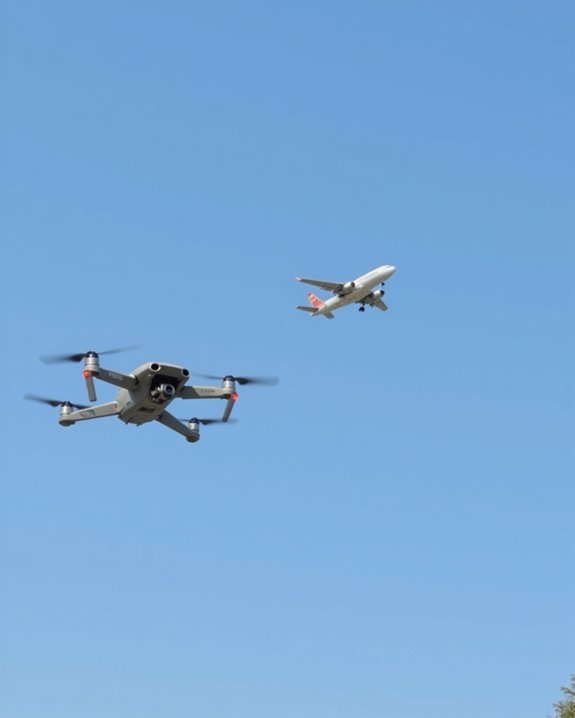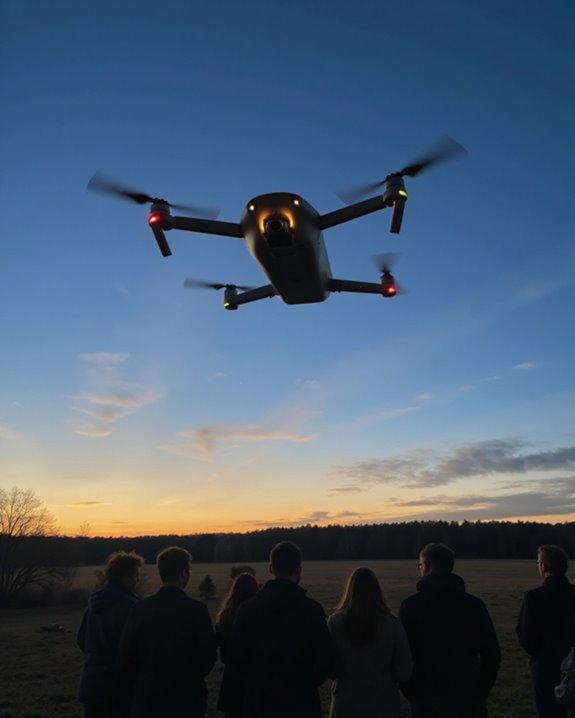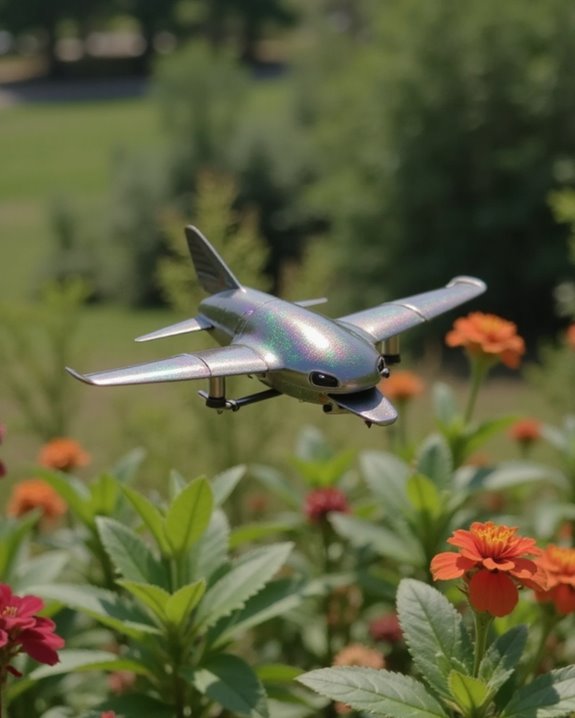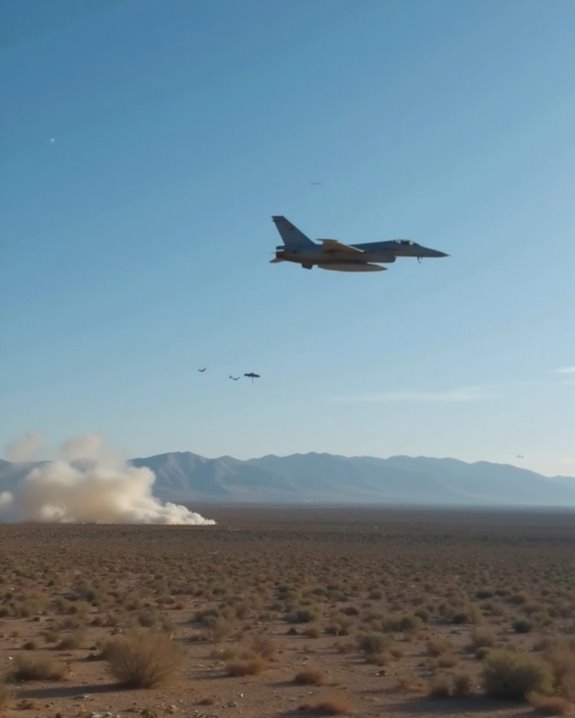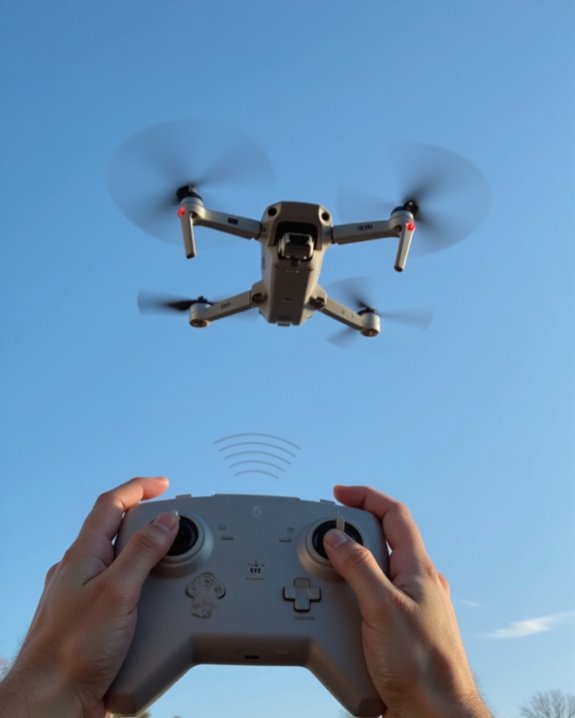Drones may look like miniature spaceships or pocket-sized airplanes in the sky, but they behave quite differently! While airplanes are loud and steady, drones usually sound more like electric bees, with high-pitched hums below 55 dBA and wild, agile flights. Their bright, square-shaped lights and quick, hovering moves give them away, unlike the traditional green and red lights and smooth flights of airplanes. If you’re curious about how drones and airplanes really contrast, there’s plenty more to discover!
Key Takeaways
- Drones and airplanes both use lights for visibility, but drones display tighter, square patterns while airplanes have wingtip and tail lights.
- Drones are much smaller, often lighter than 249g, while airplanes are constructed from heavy metals and are significantly larger.
- Drones can hover, move sideways, and change altitude rapidly, unlike airplanes which follow steady, linear flight paths.
- Drones produce quieter, higher-pitched noise compared to the louder, deeper sounds of airplanes and helicopters.
- Airplanes require onboard pilots for transport, while drones are remotely operated for tasks like photography or surveillance.
Noise and Sound Differences
When it comes to noise and sound, drones and airplanes might seem like distant cousins at a family reunion—related, but with wildly different personalities! Drones, such as the Mini 3 Pro or DJI Mavic 3, show off unique acoustic profiles, with some small models humming quietly at around 50 dBA from 100 meters up, while larger quadcopters can hit 55 dBA. Compare that to airplanes roaring at a whopping 75 dBA—or helicopters blasting 95 dBA—at the same height! Yet, it’s not just about loudness. Drone noise features sharp, high-frequency tones and rapid pulsing, giving it a distinct “buzz” that many people actually find more annoying. This is all about psychoacoustic impacts—how our ears and brains react to the sound, not just the numbers! The best stealth drones achieve noise reduction below 60 dB, making them significantly quieter than conventional drones.
Lighting and Visibility Characteristics
Spotting something soaring above your head at night isn’t always as simple as you’d think! Drones and airplanes both follow strict Visibility Regulations, but their Light Patterns are quite different. Airplanes use a classic set-up: red on the left wing, green on the right, and white at the tail, so you can tell which way they’re facing. Drones, on the other hand, often display tight square or rectangular light patterns—think of them as tiny flying Rubik’s cubes! Both must use anti-collision lights visible from at least three miles away. Airplanes flash strobe and beacon lights, while drones use bright, strobing LEDs to reduce eye strain. At night, telling them apart by their lighting can feel like a high-stakes game of “Guess That Glow!” Modern drone lights, such as the HeiyRC 3.7-mile night strobe, enhance visibility significantly for safe night flying.
Size and Design Contrasts

Although drones and airplanes both rule the skies, their size and design differences are hard to miss! Just imagine a nano drone, barely heavier than a chocolate bar, fitting neatly in your palm, versus a massive passenger jet stretching across a runway. Drones come in defined size categories, from tiny palm-sized models to large ones rivaling small aircraft. Their material choices—like carbon fiber and lightweight plastic—make them easy to carry, toss in a backpack, or even fold up for storage. Airplanes, on the other hand, use heavier materials such as aluminum and steel for durability and strength, but definitely won’t fit in your locker! While drones are shaped for specific uses, with foldable arms and sleek designs, airplanes keep their classic, fixed-wing look. Many drones weigh under 249g, allowing for FAA registration exemptions that make them more accessible to casual users.
Movement and Flight Pattern Variations
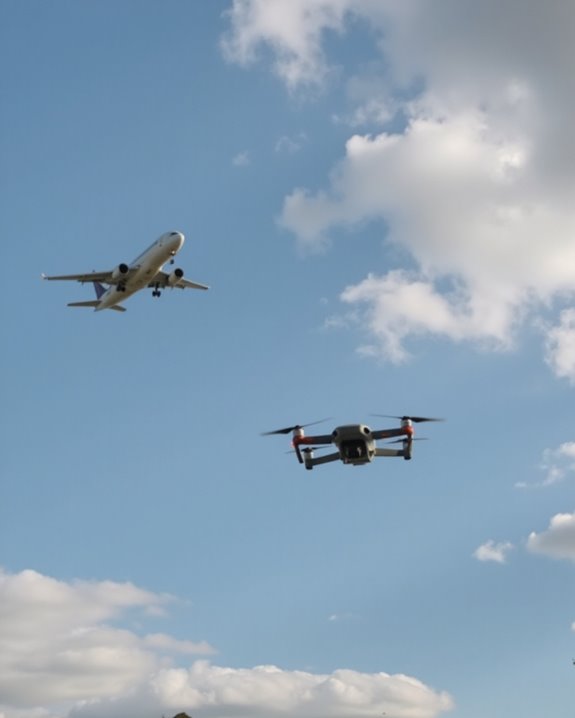
If you’ve ever watched a drone zip and zigzag through the air, it’s easy to see how their movement styles set them apart from airplanes! Drones can hover in place like a hummingbird, change direction suddenly, and even move sideways—a trick most airplanes can only dream of. When it comes to altitude control, drones climb or descend in seconds, while airplanes follow strict altitude guidelines. Speed adjustments are quick and dramatic for drones, but airplanes generally move at a steady pace, almost like they’re on cruise control. Drones can follow custom paths, even grid or waypoint patterns for tasks like mapping, which is pretty cool! In contrast, airplanes stick to predictable aerodynamic paths. Clearly, their movement and flight patterns couldn’t be more different!
Operational Use and Identification
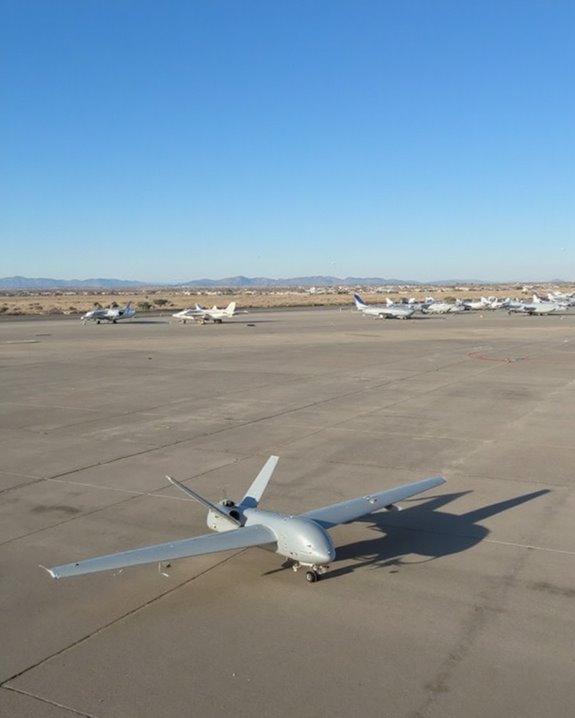
Ever wonder how to tell a drone from an airplane when they’re both buzzing around up in the sky? Here’s a clue: drones are usually much smaller, often zipping by with a remote operation system, while airplanes need a real-life pilot in the cockpit. Drones are the go-to for aerial photography, inspections, or even sneaky surveillance, but airplanes mostly carry people or big shipments over long distances. If you spot tight, square lighting patterns, that’s probably a drone! Airplanes have lights on their wings, nose, and tail—think “Christmas tree, but with wings.” Both must follow regulatory compliance, but drones face stricter altitude limits and unique license rules. So, next time you look up, you’ll know what’s flying overhead!
Frequently Asked Questions
Can Drones Be Used for Passenger Transport Like Airplanes?
The use of drones for passenger transport is advancing, driven by improvements in technology readiness and economic viability. Passenger drones are expected to enable urban air mobility, with growing market projections and continued development of supporting infrastructure and regulations.
How Long Can Drones Fly Compared to Airplanes?
While drones flutter like fleeting fireflies, airplanes soar tirelessly across continents. Flight time for drones hinges on battery life, spanning 20 minutes to 15 hours, whereas airplanes, fueled by aviation fuel, often exceed 16 hours aloft.
Are Drones Environmentally Friendlier Than Airplanes?
Drones are generally considered environmentally friendlier due to superior battery efficiency and substantially reduced emissions. Their quieter operation lessens wildlife impact, while lower energy consumption and minimal noise pollution support sustainability compared to fossil fuel-dependent airplanes.
Do Drones Require Pilot Licenses Similar to Airplane Pilots?
Drone pilots must obtain a remote pilot certificate for commercial use, but requirements differ from airplane pilot licenses. International licenses are generally not recognized. Recreational pilots are exempt from licensing but must still adhere to specific safety regulations.
Can Drones Be Tracked by Radar Like Airplanes?
The Current Question examines whether drones can be tracked by radar. Due to their radar evasion capabilities and small size, specialized tracking algorithms and advanced radar systems are required to effectively detect, classify, and follow drones, unlike traditional aircraft.

